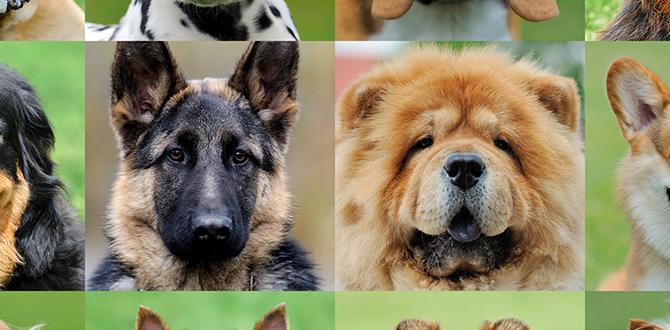Do you know that older dogs still love to play? Their behavior might change, but play remains important. Playtime keeps them happy and healthy. It’s fun to see how older dogs adapt their play as they age. Ever wondered how dog play behavior in older dogs works? Let’s find out more!
Key Takeaways
- Play remains important for older dogs’ health and joy.
- Understanding dog play behavior in older dogs is key.
- Older dogs may prefer gentler play activities.
- Toys can help engage older dogs in play.
- Watch for signs of discomfort during playtimes.
Understanding Play Changes in Older Dogs
As dogs age, their play behavior changes. They might not run as fast or jump as high. This doesn’t mean they don’t want to play. Older dogs often enjoy slower, calmer activities. It’s important for owners to adjust playtime to match their dog’s energy and health.
- Older dogs may show less interest in chasing.
- Gentle tug-of-war can be fun.
- Interactive toys are great for mental stimulation.
- Shorter play sessions can prevent exhaustion.
- Older dogs enjoy routine and consistency.
Every dog is different, and their play preferences can vary. Some older dogs may still enjoy a game of fetch, while others might prefer a relaxing walk. Owners should observe their dogs and notice what makes them happy. Adjusting to the needs of older dogs ensures they get the exercise and interaction they need.
Fun Fact or Stats : Did you know dogs sleep more as they age, often up to 18 hours a day?
Why Do Older Dogs Play Differently?
Have you ever wondered why older dogs play differently? As dogs age, their bodies change. Joints might get stiffer, and energy levels decrease. This change affects how they play. For example, an older dog may prefer gentle games. Owners need to pay attention to these changes. By understanding, they can provide activities that fit their dog’s abilities. It helps keep older dogs happy and active without causing stress or pain.
Adapting Play for Senior Dogs
How can we adapt play for senior dogs? It’s simple! Start with low-impact activities. Walks are perfect. They provide exercise without straining joints. Puzzle toys can keep their minds sharp. Tug toys can be fun, but avoid pulling too hard. Always watch for signs of tiredness. Adjust playtime to suit their needs. A happy older dog is one that feels safe and cared for during playtime.
Toys Suitable for Older Dogs
What toys are best for older dogs? Soft, plush toys are gentle on teeth. Squeaky toys can still excite them. Interactive toys, like treat-dispensing puzzles, keep their minds active. Avoid hard rubber toys that can be tough on aging teeth. Plush toys provide comfort and fun. Always choose toys that match your dog’s size and bite strength. The right toys make playtime enjoyable for your older dog.
Signs Your Older Dog Wants to Play
Do you know the signs when an older dog wants to play? It might be different from younger dogs. They may bring a toy and nudge you. Often, their tail wags slowly, inviting you to join in. Sometimes, they may bark softly or give a playful bow. Recognizing these signs helps you engage with them and make playtime enjoyable.
- Bringing a toy to you.
- Wagging their tail gently.
- Soft barking or whining.
- Playful bowing.
- Excited prancing around.
Understanding your dog’s signals is key. Older dogs may not jump around like they used to. Instead, they communicate in subtler ways. Noticing these cues helps to bond with your pet. Engaging with them when they show these signs increases their happiness and satisfaction.
Fun Fact or Stats : Older dogs can understand up to 165 words!
Responding to Your Dog’s Play Signals
How should you respond when your older dog wants to play? First, be attentive. When they bring you a toy, show interest. Join them on the floor, if possible. Use a gentle voice to encourage them. Match their energy and play style. Keep sessions short and enjoyable. Ending on a positive note ensures they look forward to the next playtime.
Building a Routine for Play
Why is a play routine important for older dogs? Routines provide structure and predictability. Dogs thrive on knowing what comes next. Regular playtimes help maintain their energy levels. Consistency in play helps reduce anxiety and stress. It also strengthens the bond between you and your dog. Setting aside time each day for play ensures they stay active and happy.
Observing Your Dog’s Reaction
Why should you observe your dog’s reaction during play? It’s important to ensure their comfort. Watch for signs of tiredness or discomfort. Slow down or stop if they seem overwhelmed. Checking their reaction helps you adjust playtimes and activities. Understanding their limits ensures their safety and enjoyment. Remember, happy play leads to a happy dog.
Benefits of Play for Older Dogs
Play has many benefits for older dogs. It keeps them physically active. Regular play helps maintain a healthy weight. It supports joint health and improves mood. Playing also stimulates their minds, reducing boredom. Mental stimulation from play can slow cognitive decline in senior dogs.
- Improves physical health and fitness.
- Enhances mood and reduces anxiety.
- Encourages social interaction.
- Maintains a healthy weight.
- Provides mental stimulation.
Playing with older dogs helps them stay engaged. It builds a strong bond between the dog and the owner. Owners should encourage different types of play for a well-rounded experience. Activities that focus on body and mind are ideal. Ensuring regular play keeps older dogs happy and healthy.
Fun Fact or Stats : Dogs can detect our moods and often mirror them!
Physical Activity and Older Dogs
Is physical activity still important for older dogs? Yes, it is! Movement keeps their muscles strong. It helps improve their balance and coordination. Regular play can prevent weight gain. It also supports joint health. Choose activities that match their physical abilities. Gentle walks or slow-paced fetch games work well. Keeping active makes them feel younger and healthier.
Mental Stimulation Through Play
Why is mental stimulation important for older dogs? It keeps their minds sharp. Puzzle games and toys challenge their thinking. New experiences help them learn and adapt. It reduces boredom and anxiety. Engaging their minds can prevent cognitive decline. Providing variety in play makes life exciting for them.
Social Benefits of Play
Can play have social benefits for older dogs? Absolutely! Playtime is a chance to bond with owners. It encourages positive behavior and trust. Playing with other dogs can improve social skills. It provides opportunities to interact safely. Social play keeps their spirits high. It reminds them of the joy of companionship.
Creating a Safe Play Environment
How can you create a safe play environment for older dogs? Start by finding a soft, open space. Remove any potential hazards. Keep play areas clear of sharp objects. Monitor your dog for signs of discomfort. Adjust play activities to match their health and energy. A safe environment gives them confidence to play freely.
| Play Activity | Benefits | Considerations |
|---|---|---|
| Gentle Fetch | Physical exercise | Use soft toys |
| Puzzle Toys | Mental stimulation | Choose easy puzzles |
| Tug-Of-War | Bonding time | Avoid pulling too hard |
| Short Walks | Overall health | Avoid hot surfaces |
- Choose safe, non-toxic play materials.
- Ensure toys are the right size.
- Avoid aggressive games.
- Inspect toys for wear and tear.
- Provide fresh water during play.
Creating a safe environment ensures older dogs enjoy playtime without risk. It’s important to check their play space regularly. By doing this, owners can prevent accidents and injuries. Safety allows dogs to focus on fun and play without worries.
Fun Fact or Stats : Dogs have an excellent sense of smell, up to 100,000 times better than humans!
Choosing the Right Play Space
Where should you play with your older dog? Choose a comfortable, safe space. Indoors or outdoors can work, depending on the weather. Make sure there are no slippery floors or sharp objects around. Ensure the area is large enough for them to move without restrictions. Comfort and safety are key to enjoyable playtimes.
Safety Measures for Play
What are the safety measures for playing with older dogs? Always supervise play activities. Keep an eye on their behavior. Make sure toys are in good condition. Avoid rough play that could strain joints. Provide water breaks to keep them hydrated. Safety measures ensure play is enjoyable and stress-free.
Monitoring Your Dog’s Health
Why monitor your dog’s health during play? Recognizing signs of exhaustion is important. Stop play if they seem tired or stressed. Watch for limping or excessive panting. Regular vet check-ups can help track their health. A healthy dog is a happy dog, even in older age.
Conclusion
Dog play behavior in older dogs is fascinating and rewarding. Understanding their needs ensures a healthy, happy life. Adjust play activities to their age and health. Encourage gentle, safe play that suits their abilities. Playing keeps them active, mentally sharp, and socially engaged. Cherish every moment with your older dog as they enjoy their golden years.
FAQs
Question: How often should I play with my older dog?
Answer: Play with your older dog daily, but keep sessions short. Adapt the activities to their energy levels and health. Regular play keeps them happy and active. Watch for signs of tiredness and adjust as needed.
Question: What toys are best for older dogs?
Answer: Soft, plush toys are gentle on aging teeth. Interactive and puzzle toys stimulate their minds. Avoid hard rubber toys that can harm their teeth. Choose toys that match their size and bite strength. The right toys make playtime enjoyable and safe.
Question: Can older dogs still enjoy social play?
Answer: Yes, older dogs enjoy social play! It provides companionship and joy. Playing with other dogs can improve their social skills. Ensure play is gentle and supervised. Social play keeps their spirits high and reminds them of the joy of friendship.
Question: How can I tell if my older dog wants to play?
Answer: Look for subtle cues. They may bring a toy, wag their tail, or bark softly. A playful bow or excited prancing is also a sign. Recognizing these signals helps you engage and enjoy playtime together. Older dogs communicate their needs in different ways.
Question: Is daily exercise important for older dogs?
Answer: Yes, daily exercise is vital for older dogs. It keeps their muscles strong and supports joint health. Regular activity prevents weight gain and improves mood. Choose low-impact activities like gentle walks or fetch. Consistent exercise ensures they remain fit and happy.
Question: How does play benefit older dogs mentally?
Answer: Play stimulates their minds, reducing boredom and anxiety. Puzzle toys and new experiences keep their brains sharp. Mental challenges can slow cognitive decline. Engaging play makes life exciting and fulfilling for older dogs. It’s important to include variety in their play routines.
Meet Elyse Colburn, the devoted canine companion and storyteller behind the enchanting world of “Tales, Tails, and Adventures Unleashed.” A passionate dog enthusiast with a heart full of paw prints, Elyse Colburn shares heartwarming tales and insightful adventures, celebrating the joy, loyalty, and endless antics that make every dog a true hero. Join Elyse Colburn on this tail-wagging journey, where every post is a love letter to our four-legged friends.








